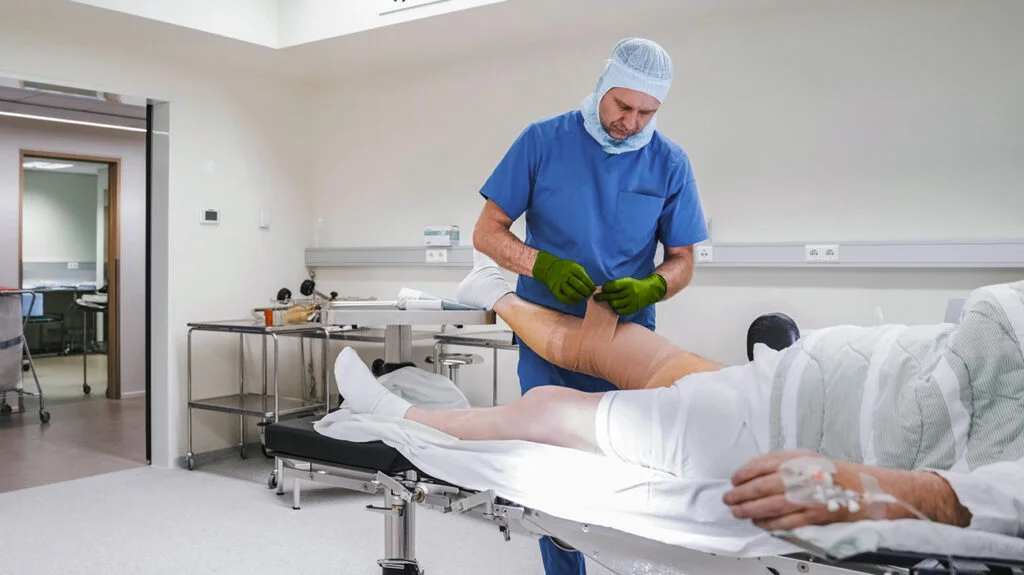Knee replacement is a life-changing procedure that can reduce chronic pain. It improves mobility and the quality of your life. But, like any major operation, recovery is key to achieving desired outcomes. You must ensure that your recovery is managed efficiently to achieve a full recovery and return of function for your knee. We’ll give you a comprehensive overview of knee replacement healing and offer tips on how you can manage the process.
The Initial Week: Immediate Post-Surgery Recovery
The first few days following a knee replacement are critical as they will set the stage for your entire recovery. The primary focus during this time is managing pain and preventing complications. You can also begin to move your joint gently.
- Treatment of pain: Your doctor will prescribe medication to help with the pain. Many doctors recommend using ice and elevating a leg to reduce swelling.
- Mobility: You will be encouraged by your doctor to move your leg as soon as possible after surgery, typically the following day. Physical therapy could begin within the first 1-2 weeks, with gentle exercises to improve your range of mobility.
The First month: Regaining strength and mobility
During recovery for a total knee replacement, the goal should be to gradually increase your strength and mobility. Your physical therapist may guide you to specific exercises that improve the flexibility and stabilization of your joint.
- Rehabilitation: Physical therapy becomes more important during this phase. You will perform exercises that improve your knee’s flexibility, strength, and range of motion. These exercises are also helpful in preventing stiffness. This is a problem that many people experience during the recovery process.
- Swelling: Swelling is common around the leg. This should begin to fade after the first couple of weeks. Continue to elevate the leg and use ice as you manage these symptoms.
- Walking: The majority of patients can walk short distances while using crutches. After the first week, most people can walk with only minimal support, but some still require assistance.
The Next Few Monthly: Building Strength and Resuming Activities
After a month, you’ll be in a phase that focuses on increasing strength and functionality. This phase can take as long as 6 months, or even longer, depending on the progress you make.
- Increasing activity: Within the second to third month, your doctor may have approved you to perform more active activities such as light stair climbing, walking, or driving.
- Physical Therapist intensifies: As you work to improve muscular strength and balance, therapy will intensify. This will enable you to return more quickly to your regular activities.
- Pain and swelling: Some discomfort and swollen may continue, but they should continue decreasing with each passing week. If swelling is noticeable, talk to your physician.
Six Months To One Year: Recovery And Return To Normal Activities
By six months after surgery, you should be able to notice an improvement in the knee’s functionality. Full recovery, however, can take anywhere from a few months to one year. Most patients are able to return to their regular activities during this period, such as climbing stairs or walking large distances.
- Strengthening for the Long Term: The focus of your physical therapy program is to continue strengthening the muscles in the area around the knee. This will ensure that you achieve long-term benefits. Regular exercise will be crucial in maintaining strength and flexibility.
- Pain-Free living: For the majority, pain and swelling should have been minimal or non-existent after one year. Some patients, however, may experience occasional discomfort. This is especially true after intense physical activities.
- Returning Work and Recreation: Many people return to work within 3 – 6 months or resume their recreational activities, like swimming or cycling. If your doctor advises you to, it may take a little longer for high-impact activities, like running.
Management Of Knee Replacement Recovery Time
It takes patience and constant effort to successfully manage the knee replacement healing time. As per your doctor’s recommendation, you should attend your physical therapies regularly, take your prescribed medications, and follow the instructions of your physician. You can also support your healing by maintaining a good diet, staying within your limits of activity, and getting plenty of rest.
In conclusion, although a knee replacement may significantly increase your overall quality of life and functional capacity, the recuperation process needs close monitoring. It is important to set realistic expectations for the knee replacement recovery time and understand how long it takes. With the correct approach, you can return to full mobility and pain-free living after knee replacement surgery.




